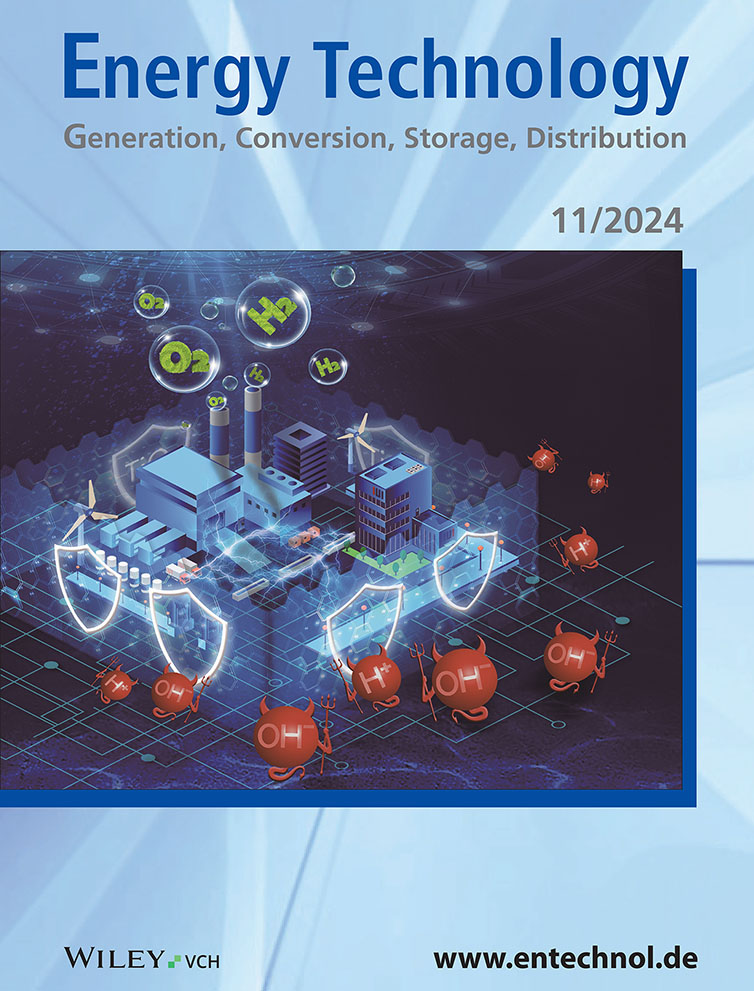Organic and Inorganic Photoactive Absorbers for Wavelength‐Selective Transparent Photovoltaic Devices: Focus Review
IF 3.6
4区 工程技术
Q3 ENERGY & FUELS
引用次数: 0
Abstract
The present status of wavelength‐selective transparent photovoltaic (TPV) devices for green buildings and self‐powered wireless sensors is comprehensively reviewed. Photoactive absorbers for both UV and near‐infrared (NIR)‐selective TPV are discussed. UV‐selective devices based on engineered small organic molecules have demonstrated high transparency (>80%). However, their power conversion efficiency (PCE) is ≈1%. Higher PCE of 3.15% and transparency of 51.4% are obtained from the bulk heterojunction (BHJ) of a wide energy gap conjugated polymer and nonfullerene acceptor (NFA). The highest transparency of 84.6% together with device stability and scalability is realized for CsPbCl用于波长选择性透明光伏器件的有机和无机光活性吸收剂:焦点回顾
本文全面回顾了用于绿色建筑和自供电无线传感器的波长选择性透明光伏(TPV)装置的现状。文中讨论了用于紫外线和近红外(NIR)选择性冠捷光电的光活性吸收剂。基于工程化小有机分子的紫外线选择性器件已显示出很高的透明度(80%)。然而,它们的功率转换效率(PCE)≈1%。宽能隙共轭聚合物和非富勒烯受体(NFA)的体异质结(BHJ)获得了更高的 PCE(3.15%)和透明度(51.4%)。CsPbCl2.5Br0.5过氧化物吸收体的透明度最高,达到84.6%,同时还具有器件稳定性和可扩展性。目前报道的少数近红外选择性热塑性光伏器件都是有机太阳能电池。使用由超窄能隙共轭聚合物和 NFA 组成的 BHJ,可获得 5.74% 的 PCE 和≈60% 的透明度。然而,目前的红外选择性器件通常受到吸收尾部的限制,吸收尾部会侵入可见光区域,导致显色性不理想。为了解决这个问题,我们提出了一个新的光谱范围比 (SRR) 参数,用于对红外选择性热塑性硫化器件的吸收体进行分类。概述了基于前沿分子轨道理论提高 SRR 的分子设计策略。
本文章由计算机程序翻译,如有差异,请以英文原文为准。
求助全文
约1分钟内获得全文
求助全文
来源期刊

Energy technology
ENERGY & FUELS-
CiteScore
7.00
自引率
5.30%
发文量
0
审稿时长
1.3 months
期刊介绍:
Energy Technology provides a forum for researchers and engineers from all relevant disciplines concerned with the generation, conversion, storage, and distribution of energy.
This new journal shall publish articles covering all technical aspects of energy process engineering from different perspectives, e.g.,
new concepts of energy generation and conversion;
design, operation, control, and optimization of processes for energy generation (e.g., carbon capture) and conversion of energy carriers;
improvement of existing processes;
combination of single components to systems for energy generation;
design of systems for energy storage;
production processes of fuels, e.g., hydrogen, electricity, petroleum, biobased fuels;
concepts and design of devices for energy distribution.
 求助内容:
求助内容: 应助结果提醒方式:
应助结果提醒方式:


